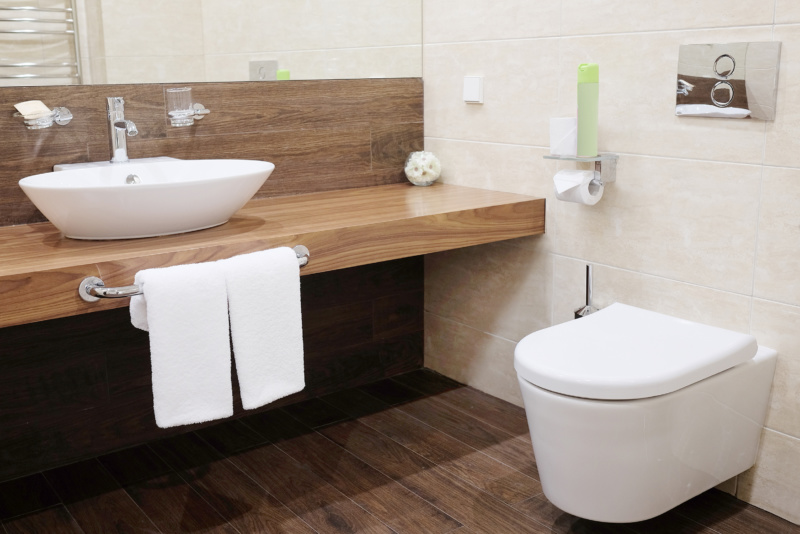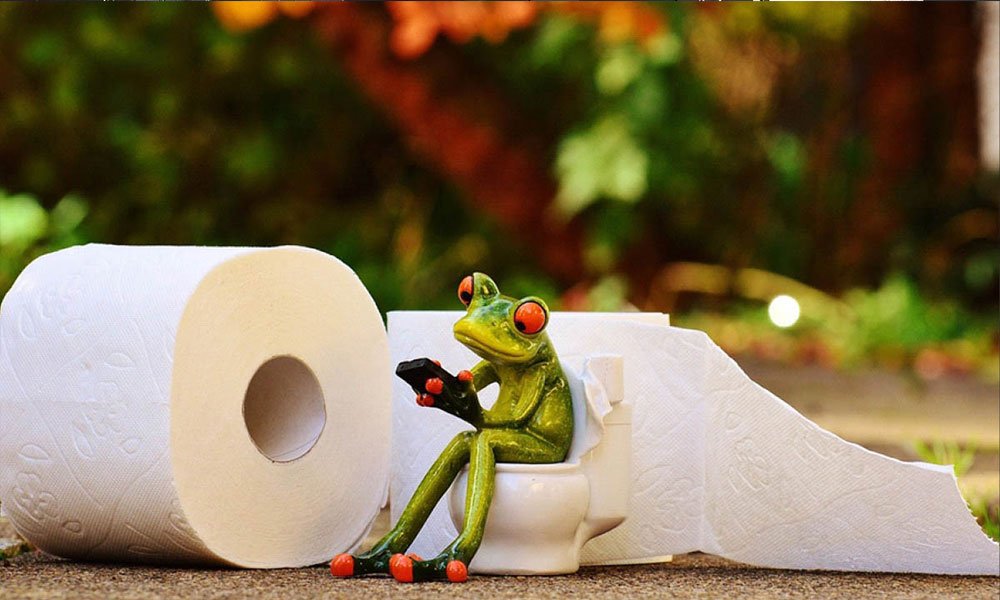Tips for Choosing a New Toilet
Taking Measurements
The first step is to measure carefully to ensure that the toilet you purchase will fit in the same location as the old one. Measuring is done with the old toilet still in place. Start by measuring from the wall behind the toilet to the center of the bolts at the base of the toilet. If your existing toilet has four bolts, measure to the center of the back bolts. This measurement is known as the rough-in measurement. For a standard toilet, the rough-in measurement should be between 11 inches and 13 inches. Keep this measurement handy when you go to purchase the replacement toilet.
Researching Your Options
With measurements in hand, it’s time to consider what options are available for your new toilet—and there are quite a few. The first option is between one-piece and two-piece models. With one-piece toilets, the tank and bowl are all one integral unit. These toilets look very sleek and have a low-profile, but they are generally more costly than the typical two-piece toilets. Since two-piece toilets are more common, they are also more competitively priced.
Bowl Shape
When choosing a toilet, you can choose from those with bowls that are elongated, compact -elongated, or round-front. Elongated toilets offer deeper seating areas and will fit most residential applications. Compact-elongated toilets have a slightly shorter footprint and take up less space while still offering good comfort. Round-front toilets take up the least space and are a good choice where space is at a premium.
Toilet Trap
Toilets can have trap configurations that are exposed—where the integral trap in the fixture is visible from the side—or the trap configuration can be hidden by the design of the fixture so that the side view of the toilet offers a flat surface. This is really a matter of aesthetics. Visible-trap toilets are a good choice for classic-style bathrooms with pedestal sinks and free-standing tubs, while hidden-trap toilets may look better in more modern bathrooms.

Choosing a Toilet: Tips to Ensure You Get the Right Fit and Flush
Measure for fit
Your first step in choosing a toilet is to find your current toilet’s rough-in measurement so you can find a model that fits your bathroom. The rough-in measurement is the distance from the wall to the middle of the toilet flange, which lines up with the center of the hold-down bolts. For a toilet with two bolts on each side, measure to the center of the back bolt. If you’re measuring from the lowest part of the wall, take the thickness of the baseboard or molding into account. Ideally, measure directly from the wall.
Choose your design
When choosing a toilet, you’ll need to decide if you want a one-piece, two-piece or wall-mount design. Two-piece toilets are the most common. These plumbing fixtures have a separate bowl and tank you can buy together or separately. Because there are so many on the market, opting for a two-piece toilet gives you a greater chance of finding one with the features you want.
Decide on bowl type
Toilet bowls are available in two shapes: elongated and round. Elongated bowls are around 2 or 3 inches longer in the front than round bowls. Round bowls never surpass 28 inches, while elongated bowls can be as large as 31 inches. Despite the fact that they take up more space, elongated bowls offer some advantages. Some individuals, including the elderly and those with physical impairments, may find the bigger seat more comfortable because it supports the thighs like a chair. These bowls also retain less soiling and hold back odors better. For some, the streamlined oval shape is more visually appealing than the traditional round shape.
Decide on height
Standard toilets are around 15 inches from the seat to the floor. Although this height is comfortable for many, you may be better off choosing a toilet with a higher seat. Seats of 17 inches high are marketed as “comfort height” and are better suited for the elderly and those with physical impairments. In fact, this is the height the American Disabilities Act requires for public toilets.
Consider a dual-flush toilet
Toilets account for up to 30 percent of the water use in the average US home. If you’ve had bad experiences with water-conserving toilets, though, choosing a toilet designed to save water may not seem too appealing. Older models of water-saving toilets simply reduced the amount of water used, leaving you with no choice about how much too use. Newer models have changed that.
How to Buy a Toilet
Understand the mechanics behind a toilet. When you flush a standard toilet, the handle pulls up a chain, which raises a flush valve. This flush valve then releases at least two gallons (about 7.5 litres) of water from the tank into the bowl in about three seconds, which triggers the siphon to suck the contents of the bowl down the drain and into a sewer system or septic tank. However, contrary to popular belief, the tank is not the most important part of a toilet’s technology. In fact, you could detach the tank from the toilet and pour two gallons of water into the bucket by hand, and the toilet would still flush.
Consider a gravity-assisted toilet. This type is the most common type in North America. These toilets use the weight and height of the water in the tank to facilitate a flush. The tank then refills via a small gushing pipe (usually plastic) until a float shuts off the flow. If any water does happen to flow a little higher from gushing, hand-motion inside, or even an earthquake, a narrow overflow tube handles any overflow problems. So, as long as the toilet is functioning properly, no water should spill outside of the porcelain tank. This type is the staple toilet, simple, effective, and durable. The flushing sound for gravity assisted toilets also isn’t particularly loud and they are easy to repair. However, if you have a lot of people using your toilet (say, a large family) or are going to be putting a lot of wear on the toilet’s flush system, gravity-assisted toilets may not have enough power to flush consistently, after every use.
Consider a pressure-assisted toilet. Unlike gravity assisted, pressure-assisted toilets have an ‘active’ rather than a passive mechanism. This type adds pressure to the force of gravity by supplying more force than the traditional unit. Water displaces air inside a sealed cylindrical tank, usually made of metal or plastic, inside the larger ceramic tank, helping to generate a larger force. However, because the water in the tank is held under pressure, it flushes with greater force, resulting in a loud flushing sound. As well, a greater amount of pressure via your toilet can put stress on older pipes and plumbing in your home, which can lead to a leak or a busted pipe.
Consider a vacuum-assisted toilet. This type innovates on the standard gravity-assisted toilet by using a vacuum that draws the water with more force into the bowl using the rim holes in the upper toilet bowl. Vacuum-assisted toilets have a cleaner, quieter flush than other models, making them ideal for a bathroom near your bedroom, or by a quiet area of your home. However, unclogging this type of toilet requires some time and skill. To unplug the bowl, you have to take the lid off and put your hand over an opening in the tank for the plunging action to work. The vacuum-assisted toilet also costs about $100 more than a gravity toilet.
Consider a power-assisted toilet. This type uses an even greater force than vacuum-assisted toilets. In fact, power-assisted toilets are known as the only “toilets with horsepower”.[1] These toilets have a 0.2 horsepower motor in the tank to literally blast waste products down the drain, making them ideal if your bathroom has old pipes. Power-assisted toilets can also save the average family 2,000 gallons of water per year. However, these toilets have a pump that must be plugged into a power outlet, they are known for their incredibly loud flushing sound and they are currently the most expensive type of toilet on the market.
Tips on Finding the Best Toilet For Your Bathroom
Shape, Height and Style
Before you head out to buy a new toilet, one of the first things you need to do is measure your bathroom space, specifically where the toilet is going to go. The most important measurement to take is the rough-in – the distance between the wall and the floor drain. This is usually around 12 inches; perhaps 10 or 14 inches for older homes.
Gravity Feed vs. Pressure-Assisted
In terms of flush, most toilets fall into two basic categories: gravity feed and pressure assisted. Gravity feed toilets are still the most commonplace, but pressure assisted is worth considering, especially if you have a large family. So, what are the differences you may ask?
Low Flush and Water-Saving Toilets
It’s fair to say that the toilet is one of the most important items in your home – even if it’s not the most glamorous. Aesthetic considerations like colour and style are important but just as important is how well it functions, and how much water it uses. A good toilet should generate enough power to effectively clear the bowl with one flush, while also conserving water as much as possible.
Better, Faster, Stronger
Who says innovation doesn’t apply to the lavatory? As with everything else, there are always people at work to make the modern toilet perform better, last longer, and work harder. What’s more, you can also find elevated toilets that are approximately 2-4 inches taller, for those who struggle to get up and sit down.
Some Final Thoughts on Choosing a Toilet
Generally speaking, boring is better. If you opt for something quirky or unusual, you may start to wish you hadn’t further down the line. For example, say you opt for something ultra cool and custom – when you come to replace those parts some years later, you’re going to need to spend much more than if you’d opted for something mainstream. Likewise, a bright pink toilet might seem like a fun option now, but when you try to sell your house some years later, potential buyers may well find it offputting.

Toilets
How We Test Toilets
To develop our toilet ratings, Consumer Reports’ test engineers put the fixtures through a battery of tests involving waste removal, bowl cleaning, and drain-line clogs. We also measure how loud a toilet’s flushes are.
To test solid-waste removal, we dump marble-sized plastic beads, weighted sponges, and filled water bags into the bowl and measure how well each flush handles the simulated waste.
We use a combination of methods to assess how well a toilet gets the entire bowl clean. First, we use red paint to draw a rectangular shape in the bottom of a clean bowl. Our testers let the bowl fill up, then draw a line using a water-soluble pen around the bowl about an inch under the rim. Next, we flush. We then measure how much red paint and pen markings are left. The better a toilet cleans, the fewer markings are left. We repeat this test three times and calculate the average to arrive at a score. To gauge odor removal, we measure how much sewage water is left in the bowl after flushing.
We also look at how well a toilet moves waste from bowl to sewer and whether there’s enough force to make sure the waste doesn’t get stuck, especially if waste travels a long way to the sewer. In our noise tests, we measure with a decibel meter how loud a toilet is during flushing.